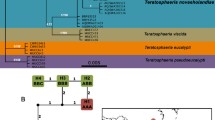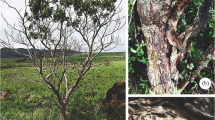Abstract
Although the first Teratosphaeria spp. with colletogloeopsis-like anamorphs were described outside of Australia, recently many new species have been described from Australia. In the present study, several new Teratosphaeria spp. were collected from infected eucalypt leaves in eastern Australia. Phylogenetic and morphological studies revealed five new taxa described here as Teratosphaeria aurantia, T. biformis, T. foliensis, T. micromaculata and T. tinara.








Similar content being viewed by others
References
Andjic V, Barber PA, Carnegie AJ, Hardy GEStJ, Wingfield MJ, Burgess TI (2007) A morphological and phylogenetic reassessment of the genus Phaeophleospora and the resurrection of the genus Kirramyces. Mycol Res 111:1184–1198
Barber PA, Keane PJ (2007) A novel method of illustrating microfungi. Fungal Divers 27:1–10
Cortinas MN, Crous PW, Wingfield BD, Wingfield MJ (2006) Multi-gene phylogenies and phenotypic characters distinguish two species within the Colletogloeopsis zuluensis complex associated with Eucalyptus stem cankers. Stud Mycol 55:135–149
Crous PW (2009) Taxonomy and phylogeny of the genus Mycosphaerella and its anamorphs. Fungal Divers 38:1–24
Crous PW, Wingfield MJ (1997) Colletogloeopsis a new coelomycete genus to accommodate anamorphs of two species of Mycosphaerella on Eucalyptus. Can J Bot 75:667–674
Crous PW, Aptroot A, Kang JC, Braun U, Wingfield MJ (2000) The genus Mycosphaerella and its anamorphs. Stud Mycol 45:107–121
Crous PW, Denman S, Taylor JE, Swart L, Palm ME (2004a) Cultivation and diseases of Proteaceae: Leucadendron, Leucospermum and Protea. CBS Biodivers Series 2:1–228
Crous PW, Groenewald JZ, Mansilla JP, Hunter GC, Wingfield MJ (2004b) Phylogenetic reassessment of Mycosphaerella spp and their anamorphs occurring on Eucalyptus. Stud Mycol 50:195–214
Crous PW, Wingfield MJ, Mansilla JP, Alfenas AC, Groenewald JZ (2006) Phylogenetic reassessment of Mycosphaerella spp. and their anamorphs occurring on Eucalyptus II. Stud Mycol 55:99–131
Crous PW, Braun U, Groenewald JZ (2007) Mycosphaerella is polyphyletic. Stud Mycol 58:1–32
Crous PW, Groenewald JZ, Summerell BA, Wingfield BD, Wingfield MJ (2009a) Co-occuring species of Teratosphaeria on Eucalyptus. Persoonia 22:38–48
Crous PW, Summerell BA, Carnegie AJ, Wingfield MJ, Hunter GC, Burgess TI, Andjic V, Barber PA, Groenewald JZ (2009b) Unravelling Mycosphaerella: do you believe in genera? Persoonia 23:99–118
Crous PW, Summerell BA, Carnegie AJ, Wingfield MJ, Groenewald JZ (2009c) Novel species of Mycosphaerellaceae and Teratosphaeriaceae. Persoonia 23:119–146
Crous PW, Wingfield MJ, Groenewald JZ (2009d) Niche sharing reflects a poorly understood biodiversity phenomenon. Persoonia 22:83–94
Ganapathi A, Corbin JB (1979) Colletogloeum nubilosum sp. nov., the imperfect state of Mycosphaerella nubilosa on Eucalyptus in New Zealand. Trans Br Mycol Soc 72:237–244
Gardes M, Bruns T (1993) ITS primers with enhanced specificity for basidiomycetes—application to the identification of mycorrhizae and rusts. Mol Ecol 2:113–118
Glass NL, Donaldson GC (1995) Development of primer sets designated for use with the PCR to amplify conserved regions from filamentous Ascomycetes. Appl Environ Microbiol 61:1323–1330
Goodwin SB, Dunkley LD, Zismann VL (2001) Phylogenetic analysis of Cercospora and Mycosphaerella based on the internal transcribed spacer region of ribosomal DNA. Phytopathology 91:648–658
Hunter GC, Wingfield BD, Crous PW, Wingfield MJ (2006) A multi-gene phylogeny for species of Mycosphaerella occurring on Eucalyptus leaves. Stud Mycol 55:147–161
Nylander JAA (2004) MrModeltest v2.2. Program distributed by the author. Evolutionary Biology Centre, Uppsala University
Ronquist F, Huelsenbeck JP (2003) MrBayes 3.1: Bayesian phylogenetic inference under mixed models. Bioinformatics 19:1572–1574
Summerell BA, Groenewald JZ, Carnegie AJ, Summerbell RC, Crous PW (2006) Eucalyptus microfungi known from culture. 2. Alysidiella, Fusculina and Phlogicylindrium genera nova, with notes on some other poorly known taxa. Fungal Divers 23:323–350
Swart HJ (1988) Australian leaf-inhabiting fungi XXVI. Some noteworthy coelomycetes on Eucalyptus. Trans Br Mycol Soc 90:279–291
Swofford DL (2000) PAUP*, Phylogenetic analysis using parsimony (*and other methods). Version 4.0b10, in: (Sinauer Associates: Sunderland, Massachusetts, USA)
Taylor JE, Groenewald JE, Crous PW (2003) A phylogenetic analysis of Mycosphaerellaceae leaf spot pathogens of Proteaceae. Mycol Res 107:653–658
Thompson JD, Gibson TJ, Plewniak F, Jeanmougin F, Higgins DG (1997) The ClustalX windows interface: flexible strategies for multiple sequence alignment aided by quality analysis tools. Nucleic Acids Res 24:4876–4882
White TJ, Bruns T, Lee S, Taylor J (1990) Amplification and direct sequencing of fungal ribosomal RNA genes for phylogenetics. In: Innes MA, Gelfand DH, Sninsky JJ, White TJ (eds) PCR protocols: A guide to methods and applications. Academic, San Diego, pp 315–322
Wingfield MJ, Crous PW, Couthinho TA (1997) A serious new canker disease of Eucalyptus in South Africa caused by a new species of Coniothyrium. Mycopathologia 136:139–145
Acknowledgements
This work was supported financially by an ARC APAI linkage project LP0349190. The authors acknowledge Sally Collins, ITC Ltd, Australia for collecting samples from New South Wales. We also thank Ewald Groenewald CBS Fungal Diversity Centre, Uppsalalaan, Utrecht, the Netherlands for BT sequences of CPC13303, CPC11264 and CPC11267. We thank Kate Taylor and Paul Barber for assistance with the drawings and Thomas Jung for Latin translations.
Author information
Authors and Affiliations
Corresponding author
Rights and permissions
About this article
Cite this article
Andjic, V., Whyte, G., Hardy, G. et al. New Teratosphaeria species occurring on eucalypts in Australia. Fungal Diversity 43, 27–38 (2010). https://doi.org/10.1007/s13225-010-0033-5
Received:
Accepted:
Published:
Issue Date:
DOI: https://doi.org/10.1007/s13225-010-0033-5




